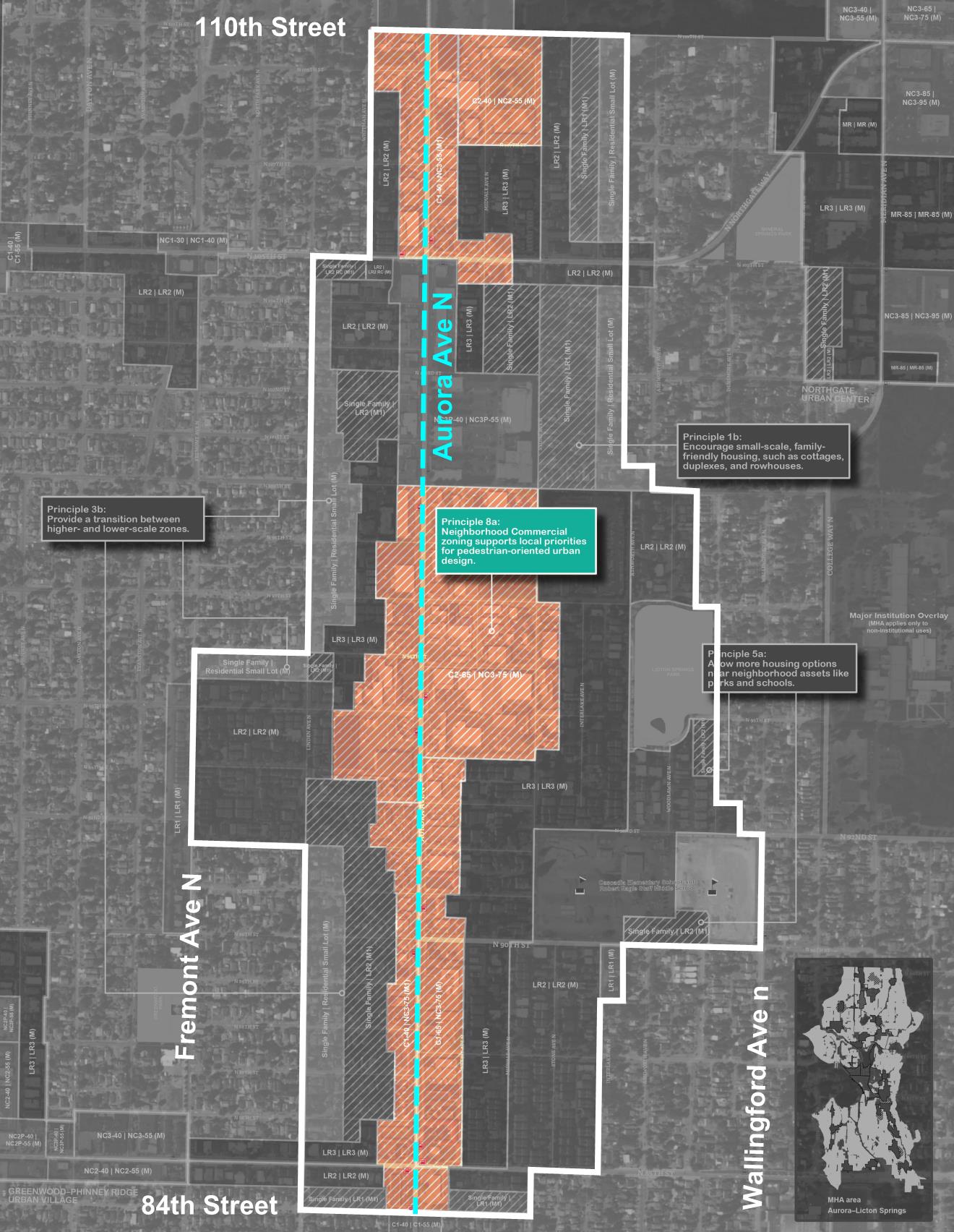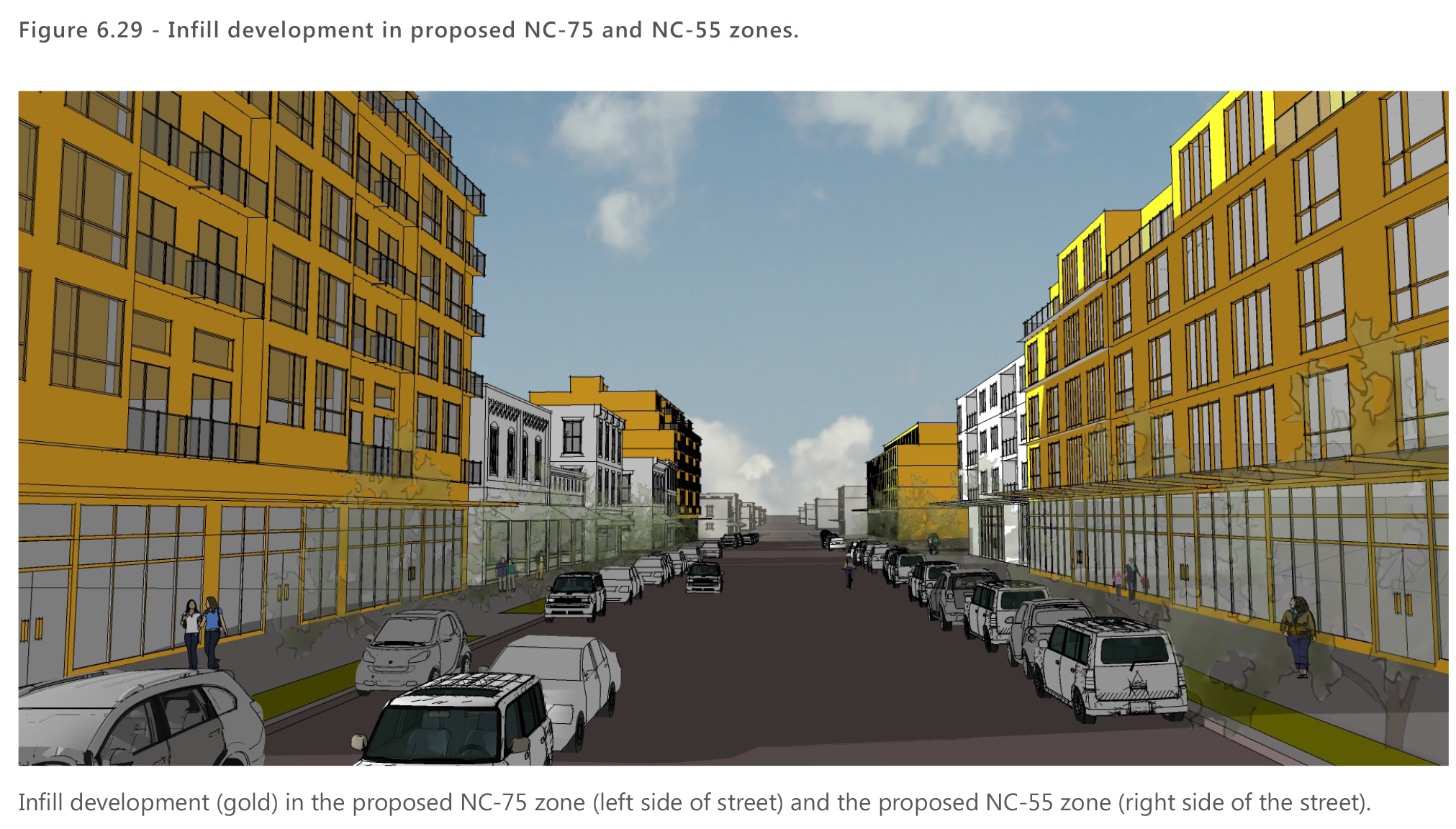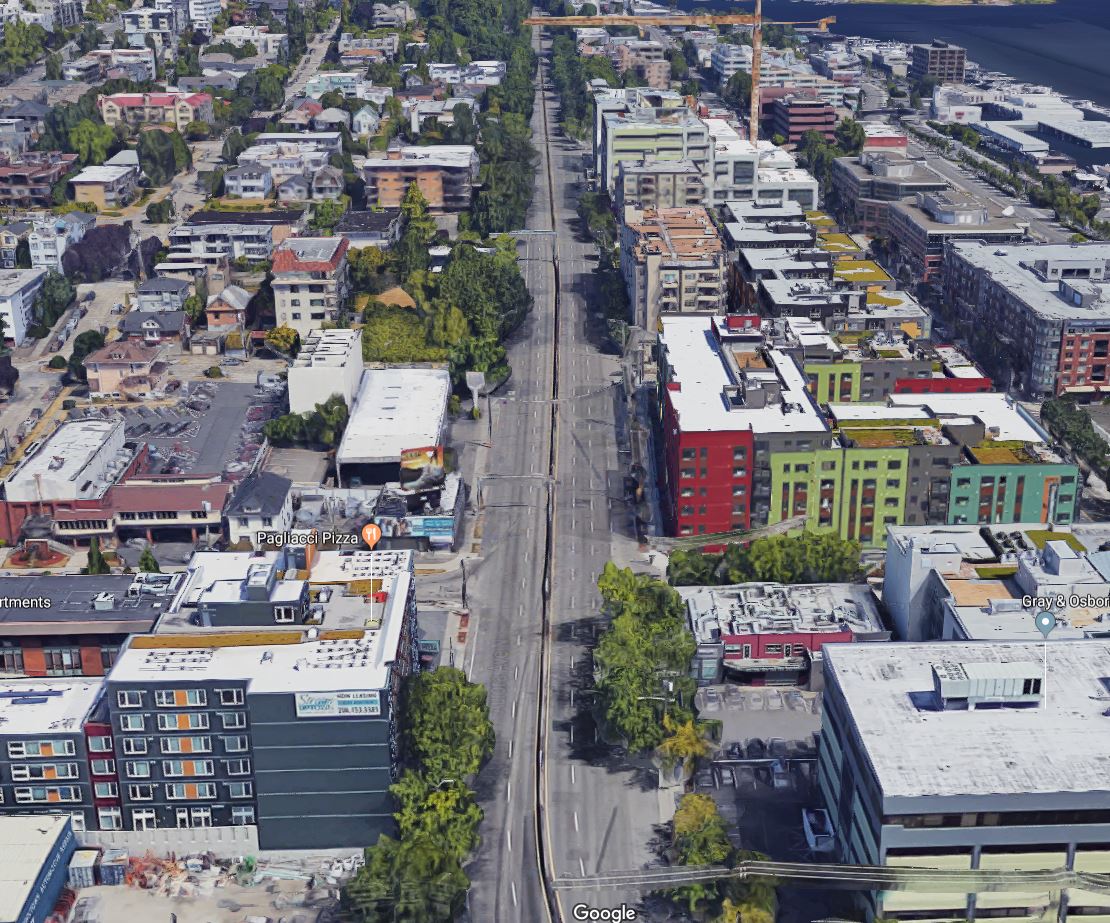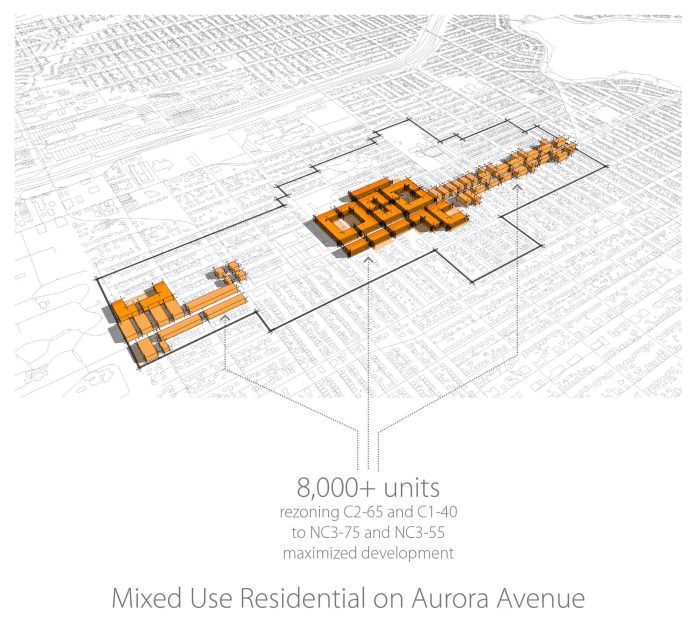Travel north on Aurora Avenue, past Lake Union, and you will see the iconic patterns of the corridor. Low budget motels, used car lots, low rise buildings set back from the street, barb wire fences, and small scale warehouses.
One more item you’ll see is busses full of passengers on a bus route with the highest ridership in all of Seattle.
Wait, really?
That’s right, some of Aurora’s future exists in the present as it zips by the zoning relics of the past. The Rapid Ride E line travels on a bus only lane carrying King County Metro’s highest daily ridership of 17,000. This is, in large part, due to the urban villages along the route that bring swaths of riders at each stop on their daily commute.
In 1994, Seattle Mayor Norm Rice recognized the region’s foreseeable population growth for the next 20 years. Rather than settling for suburban sprawl, his office established 30 neighborhoods targeted for added residential growth with hopes of adding jobs, increasing diversity, and upgrading transit services.
In 2014, that goal of 75% growth was achieved by adding 74.7% of the city’s housing units within these 30 urban village boundaries. One of those neighborhoods, the Aurora Licton-Springs Urban Village, is centered on Aurora Avenue between N. 84th Street and N. 110th Street. The 212 acre urban village stretches several blocks to the east to the west of Aurora Avenue. Of the 212 acres, 155 acres is zoned residential while 57 acres is zoned commercial.

From 1994 to 2014, the Aurora Licton-Springs Urban Village’s residential acreage added 1,000 housing units, a growth rate of 39%. The commercially zoned acreage added less than 100 housing units. The residential demographics shifted from 81% white to 66% white. Job growth decreased by 15%. This is because Aurora was, and stayed, zoned Commercial 1 and Commercial 2–zoning districts reserved for auto-oriented commercial and light industrial use. With limited job growth and large land mass needs, nobody should be surprised Seattle’s Housing Affordability and Livability Agenda (HALA) labeled this stretch of Aurora Avenue as “low access to opportunity.”
During the establishment of the urban villages the city was met with resistance. Some commercial land owners along Aurora Avenue preferred their zoning designation to remain, despite the city’s desire to rezone Commercial 1 and Commercial 2 lands to a more residential-friendly Neighborhood Commercial. As an aside, Commercial 2 does not allow residential use unless the applicant meets guidelines assuring noise, smells, and industrial uses nearby remain minimal. A difficult achievement when Commercial 2 is littered with compliant auto shops, industrial businesses, junk yards and warehouses.
These commercial landowners achieved their goal, preserving their auto-oriented zoning. The Aurora of yesterday remains the Aurora of today. After fighting land use changes, they then fought the bus only lanes. This time they lost, signaling a shift within the Seattle City Council. That shift fueled the E Line’s success.
It’s now 2018 and the city is turning to its urban villages once again to handle the city’s unprecedented growth. But for Aurora-Licton Springs, where can that be? The residential land has achieved the city’s goals and has some room to grow, but not at the highest capacity available. In addition to being adjacent to the highest served transit line in the city, the commercial land has the tallest allowable construction opportunities (ranging from 40 to 65 feet in height).
Currently, there are two proposals for multi-level storage facilities and one proposal for an industrial equipment rental business along the Aurora Avenue corridor. These uses do not reflect the building typologies an urban village should serve, nor are they answering the needs of the city. Once again, low access to opportunity. We should be housing people, not things. We should be employing people and encouraging small business growth.

HALA now proposes a zoning change from Commercial 1 and Commercial 2 to Neighborhood Commercial, which caters to a building type that adds residential, small shops, and a dense walkable environment. This change is needed now more than ever. Rezoning this one-mile stretch of Aurora Avenue has capacity to add more than 8,000 residential units atop hundreds of neighborhood servicing retail businesses.

And before you wonder about Aurora, the state highway, being an undesirable location for residential buildings, study its ingredients. This one-mile stretch has two dedicated bus only lanes. It has six traffic lights, and speeds of 35 miles per hour. This segment of Aurora doesn’t even rank in Seattle Department of Transportation’s top 10 trafficked streets in the city. It’s no more a state highway than 15th Avenue NW. Aurora’s commercial lots also span two blocks deep. While frontage on Aurora is necessary, quieter side streets also provide opportunity for residential focused development and a softer edge for coffee shops, restaurants, and retail shops.

Urban villages are about housing people, not things.
This is not only the Aurora the city needs, it’s the Aurora the residents want, the Aurora of the future. City Council has been flooded with letters of support. Attend any hearing and you will hear neighbors’ preference for a rezoned, revitalized Aurora. At a time when neighborhoods have banded together to challenge the MHA Final Environmental Impact Statement, this neighborhood is unique in its large support for Aurora’s rezone.
Seattle has grown by 114,000 people in the last seven years. Density is not just desired, it’s the only option. Many commercial sites in this neighborhood carry a capacity of 200+ units and a handful of businesses at the base. HALA’s goals are modest at best and hope to handle the city’s population growth past 800,000.
The rise of Aurora in the 1950s was inspired by forward thinking as the 1962 World’s Fair approached. Aurora embraced the rapidly changing demographic needs which saw the rise in middle class family automobile use and became part of the city of tomorrow.
It’s time for Aurora to shift to the new desires and needs of a generation. It’s time to be innovative once again. It’s time for the city to honor the urban village commitment fully, not partially. It’s about housing people, not things.
Ryan DiRaimo is a resident of the Aurora Licton-Springs Urban village and a board member of the neighborhood group ALUV. He works at an architecture firm downtown and was a selected participant of the HALA Focus Group. He advocates for a denser Seattle so future generations are not priced out. You can find him on Twitter @pushtheneedle.

Ryan DiRaimo
Ryan DiRaimo is a resident of the Aurora Licton-Springs Urban Village and Northwest Design Review Board member. He works in architecture and seeks to leave a positive urban impact on Seattle and the surrounding metro. He advocates for more housing, safer streets, and mass transit infrastructure and hopes to see a city someday that is less reliant on the car.


